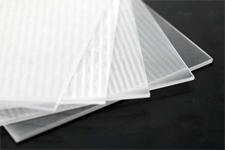Overview
Lenticular printing is a process that involves printing multiple images on a single sheet and then using a lenticular lens to create the illusion of depth, motion, or animation. It’s often used for promotional materials, packaging, and novelty items.
Lenticular Lens
The primary component of lenticular printing is the lenticular lens sheet, which has rows of cylindrical lenses on one side and a flat surface on the other. The lens sheet is crucial for creating the desired visual effects.
How does it work?
Lenticular printing works by strategically placing multiple images (called “frames”) underneath the lens sheet. These images are divided into thin strips, and the lens magnifies and displays the appropriate strip when viewed from different angles. This gives the illusion of movement or depth as the viewer changes their perspective.
Creating Lenticular Images
To create lenticular images, several techniques can be employed, including 2D to 3D conversion, animation, or simply selecting appropriate images that can be interlaced to achieve the desired effect.
Printing Process
The actual printing process involves either printing the various image frames (an interlaced image) onto the backside of the lenticular lens sheet or laminating the lenticular sheet on an interlaced image printed on substrates such as paper or plastics. High-resolution printing is essential to maintain image clarity and quality.
Applications
Lenticular printing is widely used in various industries, including advertising, packaging, and entertainment. It’s commonly seen in products like posters, business cards, postcards, and even children’s books, where it adds an engaging and interactive element.
Advantages
Eye-Catching: Lenticular printing grabs attention due to its ability to create dynamic and visually appealing effects.
Interactive: Viewers can engage with the images by changing their viewing angle, which enhances the user experience.
Memorable: Lenticular prints tend to leave a lasting impression on viewers, making them effective for marketing and advertising.
Challenges
Production Costs: Lenticular printing can be more expensive than traditional printing methods due to the specialized equipment and materials required.
Limited Viewing Angles: The effectiveness of lenticular prints depends on the viewer’s angle of sight, which can limit their impact in certain situations.
Artwork Complexity: Creating lenticular images can be a complex process, especially for animations or 3D effects, requiring skilled designers and careful planning.
History
Lenticular printing has a history dating back to the 1940s when it was initially developed for creating 3D movie posters and novelty items. Over the years, advancements in technology have made it more accessible and versatile.
Modern Applications
Today, lenticular printing is used in a wide range of applications:
Advertising: Lenticular posters, signage, and displays are used to make advertisements more engaging and memorable.
Packaging: Lenticular labels and packaging can stand out on store shelves and provide additional product information or branding.
Education: Lenticular materials are used in educational tools and books to explain complex concepts visually.
Art and Photography: Some artists and photographers use lenticular printing to create unique and immersive artworks.
Future Developments
As technology continues to advance, lenticular printing may become more accessible and cost-effective. This could lead to its increased adoption in various industries.
In summary, lenticular printing is a fascinating technique that leverages the properties of lenticular lenses to create captivating 3D or animated images. It finds applications in advertising, packaging, education, and art, offering a unique and interactive way to engage viewers. While it presents some challenges, ongoing technological advancements may further expand its use in the future.





